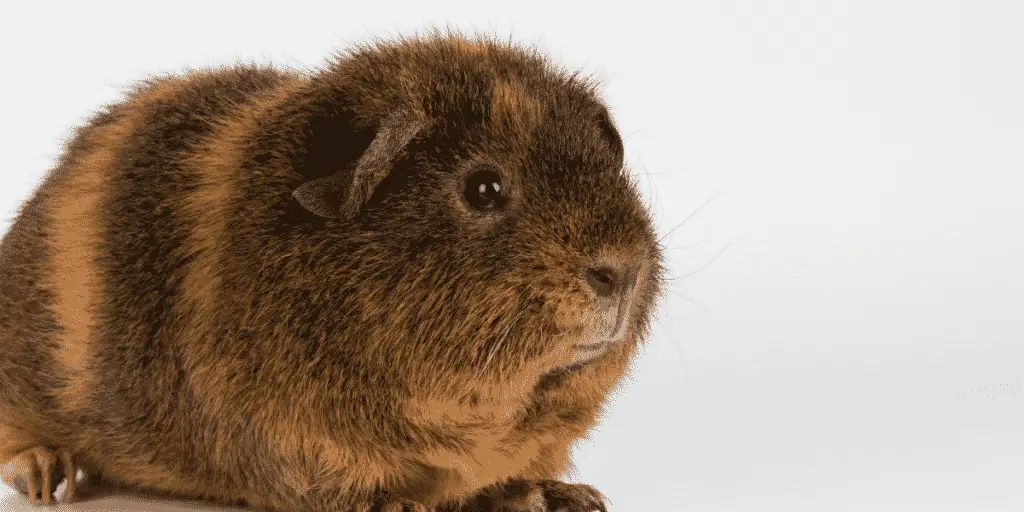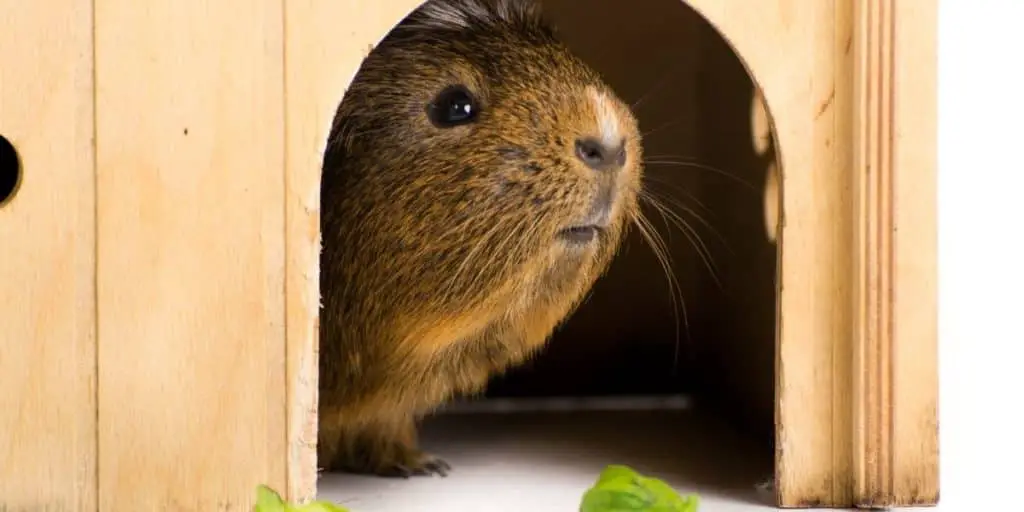
If you’re looking for a new pet to add to your family, the Rex Guinea Pig may be just what you’re looking for!
These little guys are cute, cuddly, and make great companions. The rex breed is perfect for those new to guinea pigs or want a couple for their children.
They love to be held and are generally very calm.
If you’re after a fairly low maintenance breed of Guinea pig the rex is ideal. Since their coats are short, they don’t need grooming every day.
In this article, I’ll teach you all about the Rex guinea pigs. This will include tips on how to care for them, what they like and don’t like, and more.
Quick Stats
- Weight: 800-1200g
- Lifespan: 6-8 years
- Appearance: Short, course coat
- Temperament: Calm, Gentle & Friendly
Rex Guinea Pig – An Introduction

The Rex guinea pig has short, curly hair, similar to the Teddy guinea pig.
They look like hedgehogs because of their rough and coarse coat!
The most significant difference between it and the other guinea pig breeds is its coat.
Many people believe that the Rex and Teddy guinea pig are the same. But there is not.
They are actually different breeds.
The History Of The Rex Guinea Pig
There is not much history on the Rex Guinea Pig. It’s believed It was brought back to Europe by Spanish explorers around the 1530s.
They are believed to have originated from South America and were pets and livestock for the people of Andes. This is said to have been roughly 5000 years ago.
There is some debate on whether or not the rex guinea pig breed is actually an official breed or not.
It is recognised as a breed by the British Cavy Council but the American Cavy Breeders don’t.
Why Are They Called Rex Guinea Pigs?
Rex Guinea Pigs are given their name because of their coat.
The most well-known creature known as rex is the Tyrannosaurus rex, otherwise known as the king of the tyrant lizards.
It does however have another meaning…
Rex is also defined as “An animal that shows genetic recessive variation in which hair/fur is very short”. – https://www.merriam-webster.com/dictionary/rex
What Do Rex Guinea Pigs Look Like?
All guinea pigs are cute but I’ve got to admit, Rex’s are my favorite. They just look amazing.
You can spot them due to their coats. Their fur is short and curly. To touch its roughness and course.
Like with other breeds, the rex guinea pig comes in many different colors with a wide range of patterns. Brown, White, Gold, Red and Black are the most common colors.
One of the things that makes the rex cavy so cute is their body shape.
They’re often known as the potato looking guinea pig. It’s because their body is the shape of a potato.
Their face is then elongated with ears that droop down.
If you’re after a large cavy then the rex guinea pig would be perfect. As it’s the biggest breed.
Rex Guinea Pigs will usually grow to be as big as 17 inches, this is 5 inches more than many of the other breeds.
Rex Guinea Pig Temperament
The Rex Guinea Pig is incredibly gentle and a very sociable cavy. As they’re docile and calm, they make a great first guinea pig for any adult or child.
Are Rex Guinea Pigs Friendly?
Yes, Rex Guinea Pigs are generally friendly and make great pets. They are very social animals and love to be around people. They are also very active and playful, and love to explore their surroundings.
It can take them a bit of time to get used to you and their new home, but once they do they will be very happy and content.
Are Male Or Female Rex Guinea Pigs Nicer?
There is no real answer to this question as both male and female Rex Guinea Pigs can be friendly and make great pets. However, some people do feel that the males are a bit more friendly and outgoing than the females.
Do Rex Guinea Pigs Bite?
Rex Guinea Pigs are generally very friendly and docile animals. However, as with any animal, they can bite if they feel threatened or scared.
It is important to always be gentle and patient when handling Rex Guinea Pigs, and to never force them to do anything they don’t want to do. If they start to get agitated or nervous, it’s best to put them down and give them some space.
Rex Guinea Pig Care Guide
The rex guinea pig is fairly easy to care for. It’s still a good idea to know how to care for them. Caring for them properly will result in them having a longer and healthier life.
Grooming
Like with any animal with short hair, it’s so much easier to groom them. You don’t need to worry about clumps of hair forming if you don’t brush them on a weekly basis.
If for any reason clumps of hair do appear, don’t try and brush them out. Since their hair is short this could cause them some discomfort. Instead you want to use some round-tip scissors to cut them out.
When it does come to brushing them, use a soft guinea pig brush and brush them twice a week.
NOTE: At first your Rex Guinea Pig might not like having their coat brushed, some do and some don’t. Stick with it and over time they will get used to it.
Bathing Your Rex Guinea Pig
Another great thing about The Rex Cavy is that they don’t need nearly as many baths as other breeds.
You only need to bathe them when they get a bit smelly, dirty or you’re not able to brush them. They’re good at cleaning their own fur normally.
Clipping Their Claws
It’s important that you do keep the claws cut and nicely trimmed. Luckily this only needs to be done once a month.
Use small animal nail clippers, these are designed for smaller pets such as your Rex Guinea Pig.
Once you start seeing the nails curl or they make noises when walking, it’s time to get the clippers out.
Exercise
A very important factor in keeping your Rex healthy is exercise, this is the same for any guinea pig.
Giving them regular exercise of 3-4 hours per day will help to stimulate their brain and help keep them in good shape.
You want this stimulation as it stops them from being bored and like any animal or even child, boredom causes behavioral problems.
Now you don’t need to take them for a walk or anything like that. Either put them in a playpen or let them roam the house. This will give them plenty of exercise.
You can make it even more fun for them and you by giving them treat led activities. Create some mazes for them to follow to find some tasty treats.
Housing Your Rex Guinea Pig

It’s important to put some thought into where you Rex is going to be living. How much space will they have, will they have plenty of room to run around or even hide?
I’d recommend getting the housing sorted before bringing your rex home.
Choosing A Cage For Your Rex Guinea Pig
The rex guinea pig is the largest breed, so you’re going to want a pretty large cage. Since you should never have them alone, you’re going to want a cage at least 7.5 square feet. This would be a minimum for 2 guinea pigs.
I’d aim for up to 10.5 square feet.
It’s important for their health that they do have a decent amount of space to run around. If the area is too small, you might find them being a lot more stressed out or suffering from behavioral problems.
Bedding
The next important thing you should think about is the bedding.
There are several different types, some are suitable whereas others are not suitable for your rex.
You need to make sure the bedding is absorbent, soft and also helps keep those nasty smells out.
A few good choices could be aspen wood shavings or fleece blankets.
I’d recommend going for the fleece blankets. They tend to last longer, are comfortable and pretty low cost.
They’re also going to be much more comfortable for your rex to sleep on.
Rex Guinea Pig Diet
The diet is something that you need to put a good amount of thought into. After all, you want them to have a balanced diet to keep them healthy and happy.
Although some tasty treats now and again wouldn’t hurt.
Below I’m going to go through foods that I would recommend and then some that you should not feed to your rex guinea pig.
Hay
Hay is very important to their diet. It makes up 80% of their diet, so it should be available to them at all times.
You want to use a good quality hay as this is usually low fat, calcium, calories and protein.
A good amount of hay will ensure your guinea pigs digestion is working correctly.
Vegetables
Since Guinea Pigs like the rex cannot produce their own Vitamin C, vegetables added to their diet is a good way of getting it into their system.
NOTE: You could try giving your rex guinea pig bell peppers or spinach.
Try giving your guinea pig around 1 cup of vegetables each day. I’d recommend mixing it up so your cavy doesn’t get bored.
They often like leafy greens such as kale, parsley, cilantro and lettuce.
You could give them carrots or parsnips but because of the starch content, you should limit these.
Fruits
Fruits are an excellent treat to give to your Rex. They will really help give your guinea pig extra Vitamin C.
The biggest problem with fruit is the sugar and the acidity, so you need to limit how much they are given.
Sugar will cause them to become too big and risk giving them health problems. Citrus fruits are also very acidic, so they can cause digestion problems such as diarrhea.
Some fruits you might want to give them could be Oranges, Kiwi, Blueberries, Tomato, Strawberries, Apple and Cucumber.
Pellets
Pellets are more often than not what you’ll see in the pet shop and something you should get plenty of.
You want to make sure that your Rex Guinea Pig has some pellets every day. 30 grams (1/8 Cup) will normally be enough.
It’s important you stay away from seed based pellets as these are high in fat and could cause choking.
I’d recommend looking for a low fat pellet that also contains added Vitamin C.
What Rex Guinea Pigs Shouldn’t Eat
There are a number of things that you should make sure you never feed your Rex.
- Dairy Products – Rex Guinea Pigs are lactose intolerant, so keep all dairy away from them.
- Meat – Since they are herbivores, meaning they don’t eat meat. You don’t need to add it to their diet/
- Bulb foods (Potatoes, onions & Garlic) – Keep bulb based foods away from your Guinea Pig, as they are poisonous.
- Avocado – The skin is poisonous so keep it away from them. The actual Avocado can cause digestive issues as they are so high in fat.
- Cauliflower and Cabbage – These are not good for a Rex Guinea Pigs health. They often cause bloat.
- Leeks, Chives, Shallows & Onions – These cause blood disorders as they are toxic, so avoid them.
- Rhubarb – Like with most small animals, all of the rhubarb is poisonous to them. This includes both the actual fruit and the leaves.
Common Questions
How long do rex guinea pigs live for
Rex Guinea Pigs generally have a lifespan of around 5-8 years. It does depend on how well they are looked after and how good their diet is.
Is a Rex Guinea Pig Okay for children?
Yes, Rex Guinea Pigs are okay for children. Rex Guinea Pigs are very social and do enjoy being around people.
However, if you have a child that is under the age of 12, they need to learn how to handle them properly and gently so they don’t get hurt.
Final Thoughts
Rex Guinea Pigs are great, they’re gentle and laid back. They look a lot like the Teddy breed crossed with a hedgehog, making it my favorite. Rexes have a lifespan of 5-8 years, so make sure you do your research before choosing one as a pet.
Rex guinea pigs should be fed hay every day to ensure proper digestion and vegetables or fruit once per day in addition to their pellet diet.
Rex guinea pigs shouldn’t eat dairy products. They also shouldn’t eat meat, bulb foods (potatoes), avocados, cauliflower & cabbage, leeks & onions. This is because they’re toxic when eaten by small animals like rex’s.
Proper care will help the Rex live longer which is why it’s important that this article provides all the information needed about them!


